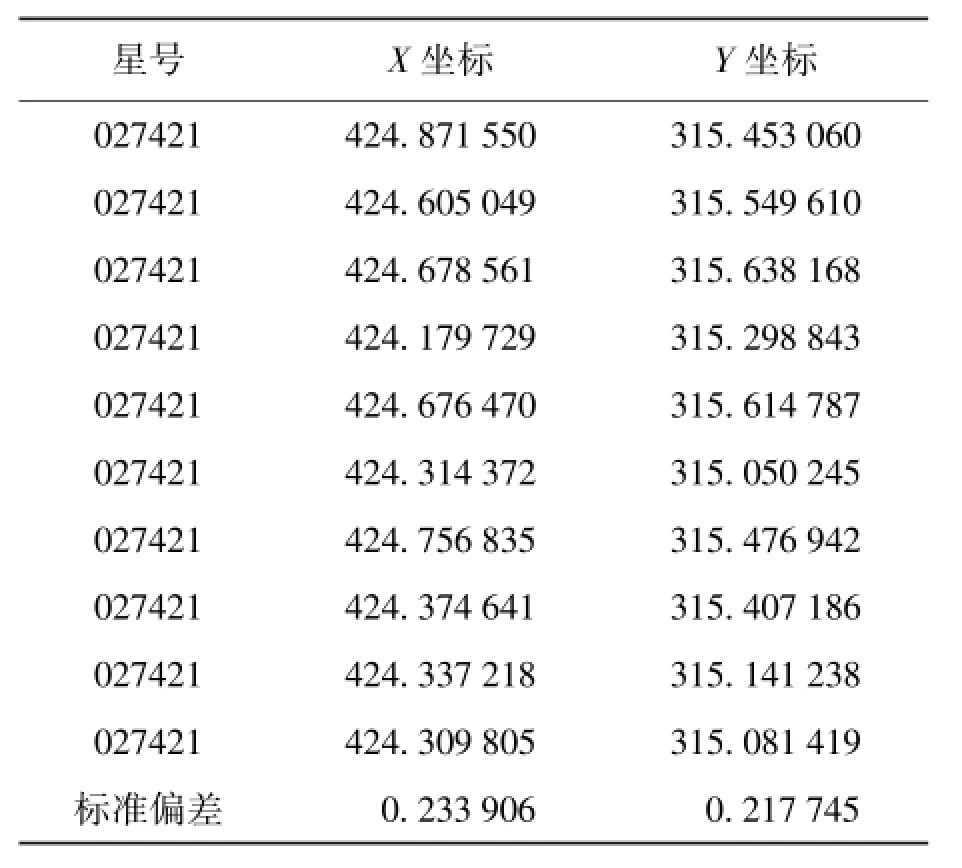多功能天文经纬仪图像处理系统
2014-05-13张益恭李彬华杨磊程向明
张益恭,李彬华,杨磊,程向明
(1.昆明理工大学信息工程与自动化学院,云南 昆明 650500;2.中国科学院云南天文台,云南 昆明 650011;3.中国科学院天体结构与演化重点实验室,云南 昆明 650011)
多功能天文经纬仪图像处理系统
张益恭1,李彬华1,杨磊2,3,程向明2,3
(1.昆明理工大学信息工程与自动化学院,云南 昆明 650500;2.中国科学院云南天文台,云南 昆明 650011;3.中国科学院天体结构与演化重点实验室,云南 昆明 650011)
多功能天文经纬仪是云南天文台新研制的一种基于通用CCD观测的天体测量望远镜。介绍了多功能天文经纬仪的图像处理系统,从系统的整体框架和主要功能算法两个方面说明了整个图像处理系统的实现流程和工作方法。介绍了星像搜索算法、定心算法和VC++程序设计的流程图。给出了图像处理软件的界面,以及恒星像、人造星像和轴准直星像3种星像的定心结果,并对其结果进行了分析。
多功能天文经纬仪;图像处理系统;编程;算法;定心
CN53-1189/P ISSN1672-7673
天体测量学主要研究高精度测定天体位置的方法及相关的仪器技术等[1]。由于目前CCD相机已广泛地用于天体测量仪器,一台仪器一个晴夜的观测可以获得大量的图像数据,因而对CCD图像中星像数据的高精度自动定位方法的研究显得非常重要。
星像的自动处理算法包括CCD图像的预处理、星像搜索、定心和数据输出,其中最关键的是搜索与定心两部分。星像搜索算法有按列搜索算法、逐点比较搜索算法等,它们各具特色[2-5]。CCD图像就星像定心算法而言,常用的算法有一维定心算法和二维定心算法,其中一维定心算法包含Gauss拟合法[6-7]、修正矩方法[5]、中值法[7]、寻导法[7]等。二维定心算法包含二维Gauss拟合法[8]、二维矩方法[7,9-10]、二维修正矩方法[8-10]、极大似然法[11]、正交滤波估计器方法[12]。对几种算法定位精度及适用性、软件实现性等方面进行比较分析后,通常认为二维修正矩方法相对其他几种算法具备定位精度较高、算法计算量小、软件实现相对比较容易等优点,是一种较为实用的算法[5,9-10,13-15]。例如,云南天文台的低纬子午环和美国海军天文台旗杆镇的8英寸天体测量望远镜(FASTT)就曾采用二维修正矩方法进行星像的定心[16-17]。
云南天文台研制的多功能天文经纬仪是一种新型的天体测量仪器,它是一台小型反射望远镜,可以用来测量大气折射改正[18-19]、铅垂线校正[20]和测定时间和纬度的残差[21]。在试观测期间,该仪器一个晴夜观测约200颗恒星;对于1颗恒星的观测,需要采集200幅1 392×1 040 pixel恒星图像、100幅1 392×1 040 pixel人造星图像、200幅768×621 pixel的轴准直光路图像和200幅768×621 pixel的电水准光路图像。如此巨量的CCD图像,必须采用高效的自动图像处理系统才能完成这200颗恒星观测数据的前期处理工作。本文介绍目前用于多功能天文经纬仪的图像处理系统,重点介绍自动星像搜索算法、定心算法及其结果。
1 系统的框架
多功能天文经纬仪获取的图像由3部分组成,主光路的图像、电水准光路的图像以及轴准直光路的图像[22]。对这些图像处理的目的是得到这3部分图像中相关星像的中心位置坐标,为后期天文归算提供原始数据。
为便于进行自动化的图像处理工作,仪器在观测每一颗恒星时,其图像采集系统已按观测纲要中该恒星的信息对其CCD图像进行了统一的命名和存储[22],所以,在进行图像处理时,首先要读取观测纲要,根据纲要中观测恒星的信息读取对应CCD图像文件,此后才能对该图像进行具体的处理工作,例如图像平滑、星像的寻找与定位等。图像处理系统的工作流程如图1。

图1 图像处理系统框图Fig.1 Block diagram of the image processing system
2 星像的搜索算法
要确定CCD图像中星像的位置,首先要对星像进行搜索,而对于不同的天文望远镜,其用途不同,所拍摄的图像中包含的星像数目也不同。对于多功能天文经纬仪,由于它的视场大小只有10′,每次观测一颗恒星,要求出现在望远镜视场里面的星像也只能是一个。因此,多功能天文经纬仪图像处理系统中星像的搜索方法,和一般的望远镜不同,也与之前低纬子午环的CCD图像中星像的搜索算法[5,16]不同,称之为多功能天文经纬仪的单星搜索算法。
在此算法中,为了防止图像中可能出现的亮点或其它类似噪声对搜索过程的影响,首先要对图像进行滤波处理。滤波的方法是对于边界上的像元,其值不变;对于非边界处的像元,以当前像元为中心采用一个3×3的正方形区域做算术平均,进行平滑滤波。滤波之后的数据与原始数据存储在不同的数组中。然后用逐行扫描的方法找出图像中的最大值点。以此最大值点为中心,取一个特定区域内的像素均值进行比较,判断此处是否存在星像。如果是星像,则此最大值点就是该星像的一个近似的中心。后面的定心算法就以该点作为星像的初始中心坐标进行定心计算。
由于多功能天文经纬仪3个不同光路获取的图像所做的处理方法差别不是很大,因此本文只介绍主光路中获取图像的处理方法。主光路获取的图像数据包含两部分图像,一部分是人造星像,另一部分是恒星像。恒星和人造星成像的特点不同,主要差异体现在星像的大小和亮度上,对两种星像的处理根据这些差异分别进行,具体的数值是根据望远镜对它们实际成像的情况确定的。此外,在有些人造星像的图像中也可能含有恒星像。因此,对这两类图像需要先进行区分之后再执行相关的图像处理,具体程序框图如图2。

图2 主光路定心算法流程图Fig.2 Program flowchart of the object-centering method through the main optical path
3 星像定心算法
同时考虑算法的适应性、精度、计算量以及软件的易实现性,多功能天文经纬仪图像中星像定心的算法采用了二维修正矩方法。


在(1)至(3)式中,x、y分别为图像上的x、y坐标;x0、y0分别为经过定心处理后的中心坐标值;I′(x,y)是经过修正的像素亮度值;I(x,y)为原始的像素亮度值;T为所取的门限值,实际的图像情况,取T为图像像素灰度的平均值。
4 图像处理结果及其分析
根据前面介绍的图像处理系统的总体框架和具体的处理算法,用VC++编写了多功能经纬仪图像处理系统的程序,图像处理系统的软件界面如图3。多功能天文经纬仪已经试观测了半年之久,也验证了本文介绍的图像处理算法的可行性以及该系统的可靠性。

图3 图像处理系统软件界面Fig.3 A screenshot of the software interface of the image processing system
对于多功能天文经纬仪所采集的星像,基本上符合高斯分布。表1中列出的数据是多功能天文经纬仪主光路系统中人造星像定心的结果,表中坐标值及标准偏差值都以像元为单位。标准偏差值表示的是单次测量的定心精度。
恒星像的定心结果如图4。图中列出了一颗恒星在连续100幅图像中的中心坐标在x、y方向的分布情况。通过直线拟合,得到x方向实际坐标值与拟合直线的标准偏差为0.523 4,y方向实际坐标值与拟合直线的标准偏差为0.380 4。
在轴准直光路中获取的多孔图像的光孔像定心数据如表2,其中相对位置差值为同一图像中两个光孔像坐标的差值。
人造星像和准直光孔像的定心结果包含了镜筒弯沉,相应光路中大气的异常折射,仪器本身的低频扰动等误差。恒星像的定心结果包含了镜筒弯沉,镜筒内大气异常折射,大气异常折射,仪器本身的低频扰动等实时误差。所有这些误差都是仪器测量系统的原始误差,需要在后续的天文数据归算过程中进行处理。

表1 人造星像定心结果与标准偏差Table 1 Coordinates of an artificial stellar profile resulting from the object-centering method and their standard deviations

图4 恒星像定心结果Fig.4 A plot of the coordinates of a star in 100 images resulting from the object-centering method

表2 准直光孔像定心结果与标准偏差Table 2 Coordinate errors of an aperture profile through the axis collimator resulting from the object-centering method and their standard deviations
5 结 论
多功能天文经纬仪图像处理系统主要包括星像的搜索与星像的定心两部分。本文根据多功能天文经纬仪图像的特点,采用单星搜索法作为恒星像和人造星像搜索的方法。在对天文图像处理中常用的几种定心的方法进行了比较分析后,选取二维修正矩方法作为多功能天文经纬仪获取的CCD图像的定心方法。通过对一组实测的图像进行处理并加以分析后,得出了人造星像的定心精度为0.234像元,恒星像的定心精度为0.523像元,轴准直图像的定心精度为0.004像元。仪器半年多的试观测证明,该图像处理系统稳定可靠,满足多功能天文经纬仪对原始测量数据的要求。
参考文献:
[1] 冒蔚,季凯帆,李彬华,等.CCD天体测量学[M].昆明:云南科技出版社,2003.
[2] Stone R C,Monet D G,Monet A K B,et al.The flagstaff astrometric scanning transit telescope (FASTT)and star positions determined in the extragalactic reference frame[J].The Astronomical Journal,1996,111(4):1721-1742.
[3] Viateau B,Réquième Y,Le Campion J F,et al.The Bordeaux and Valinhos CCD meridian circles[J].Astronomy and Astrophysics Supplement,1999,134:173-186.
[4] Lopes P A A,Andrei A H,Puliaev S P,et al.Observations of radio stars at the Valinhos CCD meridian circle[J].Astronomy and Astrophysics Supplement,1999,136:531-537.
[5] 李彬华.低纬度子午环控制系统及数据预处理系统的研究[D].昆明:中国科学院云南天文台,2002.
[6] Auer L H.The stellar atmospheres problem[J].Journal of Quantitative Spectroscopy and Radiative Transfer,1971,11(6):573-587.
[7] van Altena W F,Auer L H.Digital Image Centering,I.[C]//Image Processing Techniques in Astronomy.Dordrecht:Astrophysical and Space Science Library,1975:411-418.
[8] 季凯帆.CCD在天体测量中的应用及数字星像处理方法[D].昆明:中国科学院云南天文台,1993.
[9] Stone R C.Positions for the outer planets and many of their satellites.IV.FASTT observations taken in 1999-2000[J].The Astronomical Journal,2000,120:2124-2130.
[10] 季凯帆,王锋.CCD图像的二维修正矩定心方法[J].天文学报,1996,37(1):85-90.
Ji Kaifan,Wang Feng.Two dimensional modified moment centering algorithm in CCD images [J].Acta Astronomica Sinica,1996,37(1):85-90.
[11] Lu C L.Digital image centering with the maximum likelihood method[J].Astronomy and Astrophysics,1993,275:349-352.
[12] Sato I,Yoshizawa M.Filtering theory with orthogonal function for two-dimensional astrometry [J].Astronomy and Astrophysics Supplement Series,1995,113:185-197.
[13] Stone R C.Positions for the outer planets and many of their satellites.V.FASTT observations taken in 2000-2001[J].The Astronomical Journal,2001,122:2723-2733.
[14] Peng Q Y.Image-processing techniques in precisely measuring positions of saturn and its satellites [J].Science in China Series G:Physics,Mechanics and Astronomy,2003,46(4):362-370.
[15] 李展,彭青玉,韩国强.CCD图像数字定心算法的比较[J].天文学报,2009,50(3):340-348.
Li Zhan,Peng Qingyu,Han Guoqiang.Comparison of digital centering algorithms based on CCD images[J].Acta Astronomical Sinica,2009,50(3):340-348.
[16] Li B H,Yang L,Mao W,et al.Automatic processing method for astronomical CCD images [C]//Proceedings of SPIE,2002,4847:305-312.
[17] Stone R C.A comparison of digital centering algorithms[J].The Astronomical Journal,1989,97(4):1227-1237.
[18] Mao W,Li B H,Yang L,et al.Constructing an observational model of the neutral atmospheric refraction delay from measured values of the astronomical refraction[J].The Astronomical Journal,2007,134(5):2054-2060.
[19] Mao W,Zhang H W,Li B H,et al.A possible means of improving the accuracy of refractiondelay correction of neutral atmosphere[J].Chinese Astronomy and Astrophysics,2007,31(2): 211-220.
[20] 铁琼仙,林辉,杨磊,等.建立经纬度异常变化三角监测网的仪器和误差的测定[J].天文研究与技术——国家天文台台刊,2008,5(4):360-364.
Tie Qiongxian,Lin Hui,Yang Lei,et al.The instruments and instrumental-error evaluation method for the triangular monitoring network of abnormal changes in the longitude and latitude of an observing station[J].Astronomical Research&Technology——Publications of National Astronomical Observatories of China,2008,5(4):360-364.
[21] 胡辉,苏有锦,付红,等.大姚、普洱地震前云南天文台时纬残差异常[J].自然灾害学报,2007,16(5):106-110.
Hu Hui,Su Youjin,Fu Hong,et al.Anomalies in time-latitude residuals at Yunnan Observatory before Dayao and Puer earthquakes[J].Journal of Natural Disasters,2007,16(5):106-110.
[22] Li B H,Zhang Y G,Yang L,et al.Image acquisition system with three CCD cameras[C]// Proceeding of SPIE,2012,8451:84512Y.
An Image Processing System for a Multi-Function Astronomical Theodolite
Zhang Yigong1,Li Binhua1,Yang Lei2,3,Cheng Xiangming2,3
(1.College of Information Engineering and Automation,University of Science and Technology of Kunming,Kunming 650500,China,Email:lbh@bao.ac.cn;2.Yunnan Observatories,Chinese Academy of Sciences,Kunming 650011,China;3.Key Laboratory for the Structure and Evolution of Celestial Objects,Chinese Academy of Science,Kunming 650011,China)
A new Multi-Function Astronomical Theodolite has been built in the Yunnan Observatory.Its main imaging device is a digital CCD camera without cooling.This paper presents an image processing system for the Multi-Function Astronomical Theodolite.The system is used to determine the centers of the stellar profiles in images obtained by the theodolite.The algorithm of the image-processing system includes two main parts,for searching the star and centering the star(object-centering),respectively.An image obtained with this instrument is unusual as it includes only one star.This makes it possible to adopt an efficient searching algorithm for the system.This is to smooth the image with a suitable method,then find the maximum-value pixel as the initial location of the center of the star.After comparing commonly used centering methods in astrometry for the adaptability,accuracy,calculation amount,and programming difficulty,we decide to use the method of two-dimensional modified moments as the object-centering method.The paper shows a block diagram of the image processing system and a program flowchart of the corresponding software written in the VC++.The paper also shows the main design of the program,a screenshot of the user interface of the software,and results of using the object-centering method to a star,an artificial stellar profile,and an aperture profile(which is through the axis collimator on the instrument).The paper finally presents a brief analysis of these results.
Multi-Function Astronomical Theodolite;Image processing system;Programming;Algorithm;Object-centering
TP391.4
A
1672-7673(2014)01-0065-07
2012-12-29;修定日期:2013-01-14
张益恭,男,硕士.研究方向:探测与成像技术.Email:zhangyigong198807@126.com
李彬华,男,教授.研究方向:天文技术与方法,电路与系统.Email:lbh@bao.ac.cn
